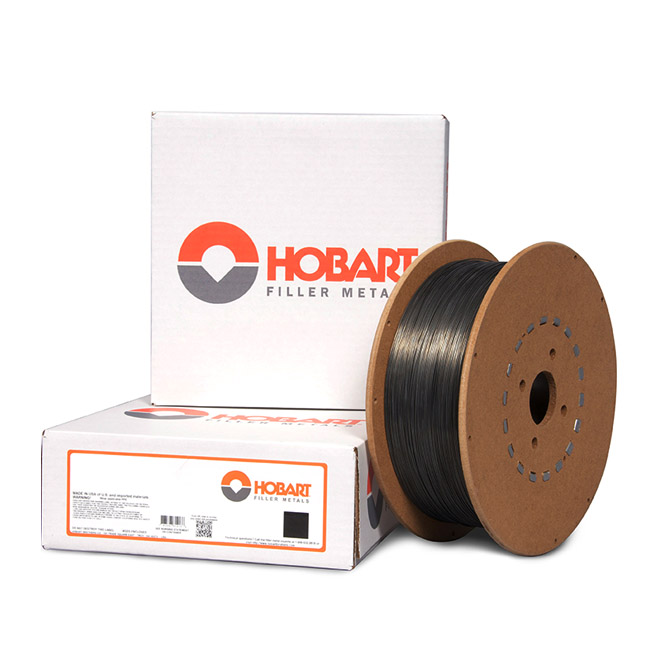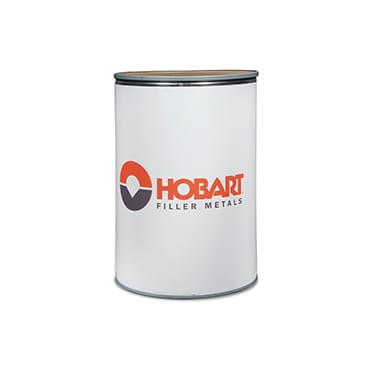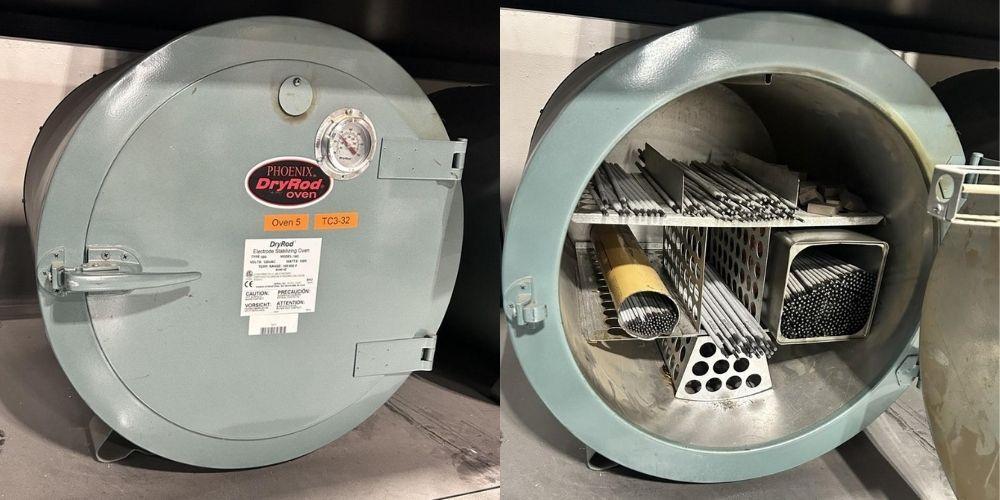Sep 30, 2025
Best Practices For Handling and Storing Filler Metal
This article was originally posted on The Welder.
Whether you are working with stick electrodes, self-shielded flux-cored wire, or something else entirely, you should be adhering to best practices for storing and handling filler metals.
After all, storing and handling filler metal improperly can lead to outcomes that are detrimental to the integrity and quality of a weld, like porosity, worm tracking, exposure to the elements, and wire feedability issues.
It should come as no surprise then that Tre’ Heflin-King, an applications engineering manager/CWI at Hobart Filler Metals, constantly fields questions on storage and handling.
“We touch upon a lot of aspects of the business,” he said. “So yeah, in terms of filler metals and especially storage and handling, these are questions that we get quite often.”
The Welder spoke with Heflin-King about how best to store and handle welding filler, the tips and advice shops should be aware of, and the answers to the questions he and his team frequently receive.
The Welder: What are some of the most common questions you get about filler metal storage and handling?
Tre’ Heflin-King: Maybe one of the most common questions is, “What’s the shelf life of a product?” We have our warranty statement where we guarantee a product in its original unopened package for up to a year after it ships to our customer. After that, it depends on how a customer stores the product.
What I always tell people is the wires are not a perishable item and won’t degrade in terms of mechanical properties of the weld. If you bought a product 10 years ago, it doesn’t mean the strength of the product will degrade in any fashion. If it was 70,000 [PSI] tensile strength when you bought it, it is probably going to be 70,000 tensile strength 10 years later.
Usually what happens is more so along the lines of the aesthetics and surface quality of the wire.
For your flux-cored arc welding products—both gas- and self-shielded—they will pick up or can pick up moisture from the atmosphere. While it won’t affect the strength, it will affect other things, such as hydrogen. Excessive hydrogen pickup can appear as worm tracks or pock marks on the surface of the weld. Worm tracking is a discontinuity that, if not addressed, can become a defect that would impact the integrity of the weld. Delayed cracking—also known as hydrogen-induced cracking or hydrogen embrittlement—is another sign of excessive hydrogen in the weld deposit.
The proper storage and handling of filler metals will go a long way in ensuring the quality and integrity of your welds. Images: Hobart Filler Metals
But you’re not losing strength. The discontinuities or defects in the weld are preventing you from achieving the desired mechanical properties.

TW: Is moisture the biggest risk when you store or handle filler metals improperly?
THK: Yes, especially for your flux-cored and your aluminum [wires]. Aluminum won’t pick up hydrogen, but when welding aluminum, you have to deal with porosity. A lot of times when dealing with aluminum, it’s really about your base material prep and how you store both the filler metals and base material.
Let’s say you store [aluminum wire] in a shed or somewhere outside, but then you bring it into your shop and your shop is cooler, it has A/C. You want to bring that wire in and let it acclimate for at least 24 hours before you weld with it. The same goes for the base material. With aluminum, you go through dew point swings that will just increase your chances for porosity. We all use the analogy of taking a can of pop out of the refrigerator on a hot day, having it sit out, and it starts to form condensation. The same thing will happen to your aluminum wire. You start to get that condensation—that’s what causes porosity.
TW: Does filler metal packaging affect shelf life?
THK: Oh, yeah, for sure. Packaging can definitely impact shelf life.
You have vacuum-sealed-type plastic bags, and we have some that are like aluminum foil. All those types of things can definitely help compared to leaving the bare product out and exposed.
Not only are you talking about potential moisture elements or moisture pickup, but also general dust and dirt collecting and getting on the wire, which can lead to feedability issues and potentially contaminate your weld if it’s too bad.
A lot of products have a spooling lube on them. Mix that with any dirt and you can just gum up your welding system.

TW: What advice do you have for properly caring for stick electrodes?
When considering a welding rod oven purchase, ask yourself how much welding you will be doing and how many rods you expect to go through.
THK: With your SMAW products, some of those can be reconditioned if they are left out or exposed. You can put those back in the oven to knock out some of the moisture and use them.
However, you also have some stick electrodes that are your cellulosic type—made from paper. You wouldn’t recondition those, and you don’t store those in an oven because they can easily dry up. It’s recommended to store them dry at room temperature.
We don’t typically recommend rebaking/reconditioning for our tubular products or our wire products—even our solid wire. We don’t typically recommend rebaking those or anything like that because there’s typically a spooling lube on there that is used to help with some arc stabilization. Any excessive baking can affect that.
And some spools, they’re fiberboard spools. You might end up damaging the spool before you damage the wire, and then you’ll have no way to use the wire.
TW: What are some other frequently asked questions you receive?
THK: “Can I rebake this wire?” That’s a common one. Again, we don’t recommend that for our tubular products or a lot of our products on spools.
Usually, it’s not something we ever get asked for aluminum. Somebody somewhere might try [reconditioning aluminum], but typically we’re not getting asked for aluminum. It’s not a concern.
Another one is, “How long can I keep the product exposed? How long can I keep it out?” For your spool-type products, we tend to say eight-hour shifts. If you don’t use it up in that timeframe, we recommend you take it off, put it back in its original bag and box, and store it somewhere not exposed to the elements.
If you’re in a low-humidity condition and in a pinch, you may not have to take it off the feeder. You can take a plastic bag or the packaging that it was in, put the bag around it, and then tie it off with a rubber band. That keeps it from being exposed to the environment it’s around, as well as avoiding any dust from your shop cleanup.
When you talk about your flux-cored products, [welders] are more concerned about hydrogen and hydrogen pickup. For some products, we do what’s called a seven-day exposure testing, where we will weld with [the wire] as received—kind of fresh out of the box—and then we will put it in a humidity cabinet of 80 degrees F at 80% humidity for anywhere from three to seven days. We’ll reweld with it and that’ll tell us how much hydrogen it picked up in that timeframe, if any. Products that are H4—which is a hydrogen designation by AWS—usually are pretty solid, and even after the seven-day exposure at 80% humidity at 80 degrees F, they don’t pick up too much moisture.
We also get this one: “I’ve had this product sitting in my garage for I don’t know how long—is it still OK?”
One of the things we will tell customers is to try welding with it. With your solid wire and your metal-cored, even some of your flux-cored, if it wasn’t stored properly, you may see rust on the wire. If your wire is not completely rusted through—let’s say it’s just a layer or two—remove those layers and try to weld with it. If the wire still looks relatively normal—it doesn’t have any excessive white spots or anything where you think something else may be going on—weld with it. If it performs normally or as you’d expect it to, then that wire is generally OK to use. Some codes and specifications have exposure limit requirements. If you are doing anything critical, we always say err on the side of caution. If you are questioning it, replace it with new product.
When we’re talking flux-cored, that’s when we would say, “Hey, if you know it wasn’t stored correctly, and this is a critical application … I know it may run OK, but from a hydrogen perspective, maybe it picked up more hydrogen.” You won’t know that until you test it. We would recommend that you get a fresh product.
But in most other cases, if you’re talking about somebody in a shop and they’re just trying to fabricate something real quick or do some tack welds, as long as the product is running normally, it’s not going to degrade from a strength standpoint.
This is also a very common question with stick electrodes. If the coating isn’t brittle and breaking off, and it’s not a cellulosic [electrode], try reconditioning it and welding with it.
TW: What should people look for when considering a welding rod oven for their stick electrodes?
THK: Before getting an oven, ask yourself, “How much welding am I going to be doing? How many rods am I going to be using?”
We at Hobart have a really good app, and one of the things on it asks how much filler metal do you need for a job. What you can do with that is you can go in, put in your joint design, how much welding you think you’ll be doing—whether that’s 20 ft. of weld, 100 ft. of weld, whatever that looks like. You select your process—MIG, stick, flux, etc.—and it’ll tell you how many pounds to buy for that project.
Let’s say you need 250 lbs.’ worth of electrodes and you know you’re going to be using them pretty extensively. That could help you decide the size of your rod oven.
TW: Do you have any advice when it comes to selecting a TIG rod storage tube?
THK: You probably want to go with a plastic tube versus metal. Depending on how that tube was manufactured, you could abrade the rods that you’re using, which may not be that big of an issue for manual TIG but could be for automated TIG processes.
With TIG rods, you want low humidity; you don’t want huge humidity swings. Any options that help control humidity will help prevent rust, corrosion, or anything like that.
TW: What questions do you typically ask welders about how they store their filler metal?
THK: I’m always curious about the creative methods people come up with for storage when they don’t have a nice shop or they’re out in the field traveling. For example, I know our sales force travels around a lot. They take samples to customers and they’re living out of hotels. It could be hot, it could be humid … they will take the wire out of their trucks and bring it into the hotel room with them, depending on what the product is. If it’s aluminum, they’ll do that. When it’s your flux cores, they may do that.
TW: Do you have any storage hacks to share with readers?
THK: From a wire storage perspective, one of the tips and tricks that people have is to take an old refrigerator and put a lightbulb at the top. You can store your wire in there, and it usually protects it from the elements, keeps it at around or a little above room temperature. I’ve seen this—it’s a nice little storage hack for people concerned about wire being exposed.
Another is if you don’t have the original box, you can throw the wire in a plastic bag and tie it with a rubber band to protect it from the elements and dirt and grime.



